Unit 1 Stay Healthy 单元知识点课件(共98张PPT)
文档属性
| 名称 | Unit 1 Stay Healthy 单元知识点课件(共98张PPT) | 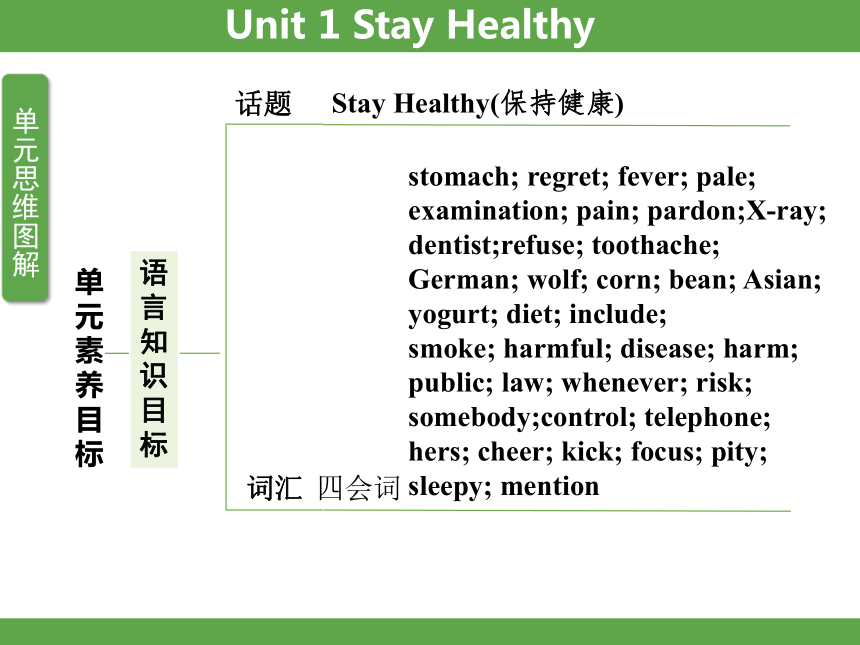 | |
| 格式 | pptx | ||
| 文件大小 | 515.0KB | ||
| 资源类型 | 教案 | ||
| 版本资源 | 冀教版 | ||
| 科目 | 英语 | ||
| 更新时间 | 2024-07-03 22:36:31 | ||
图片预览

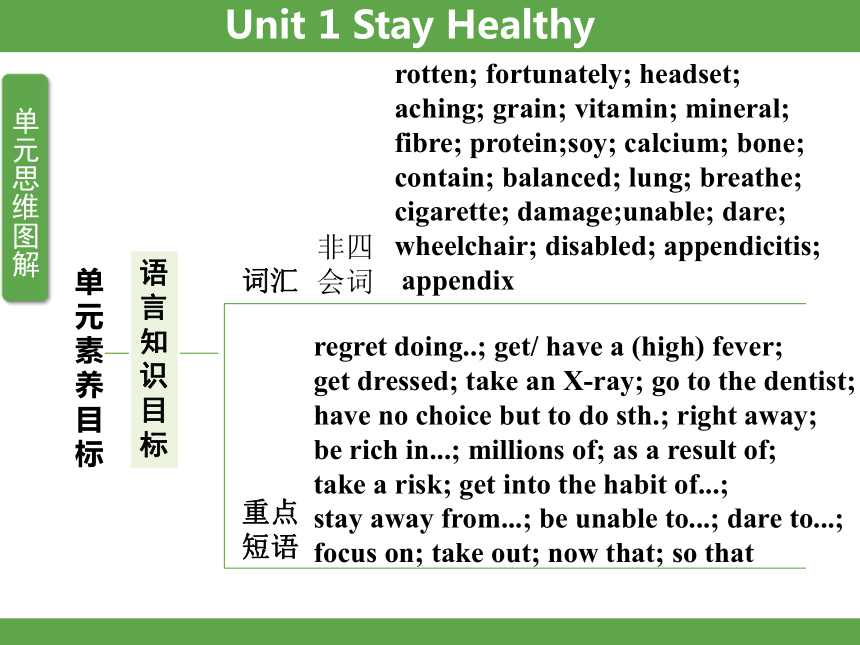


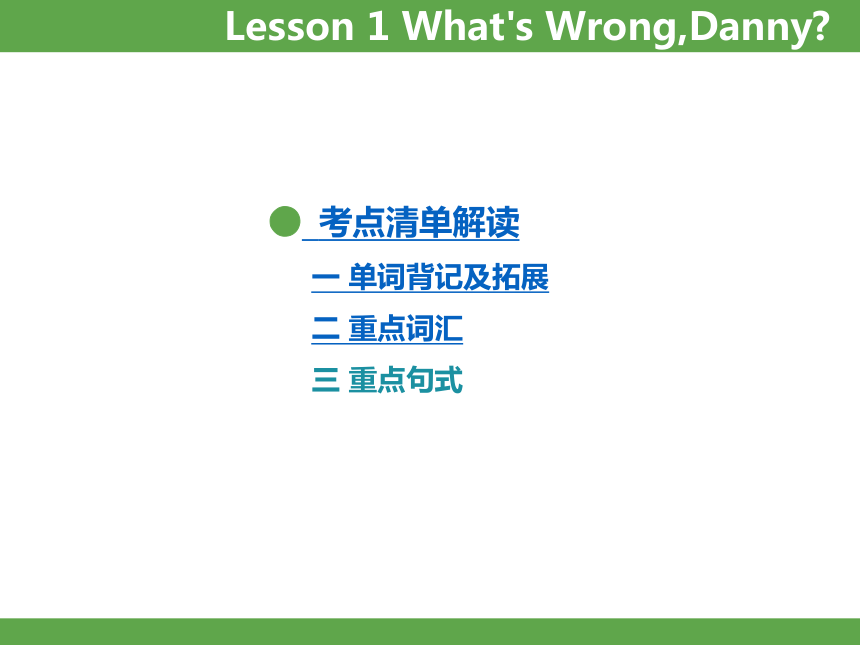
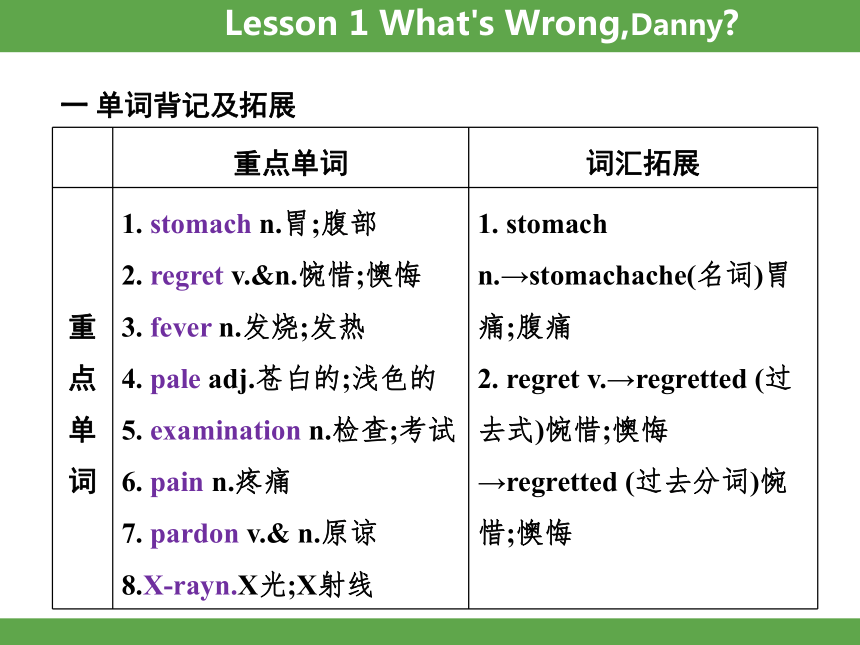
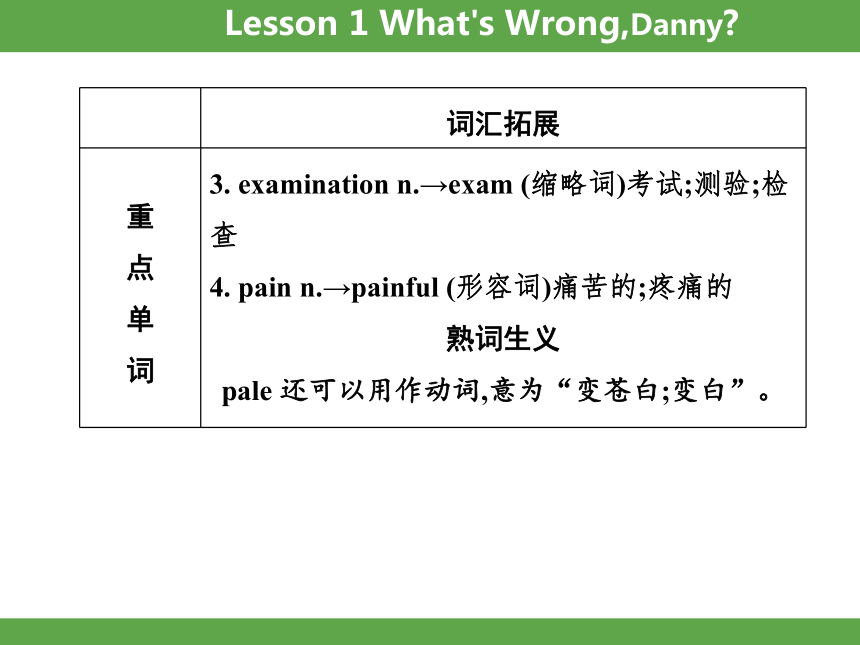
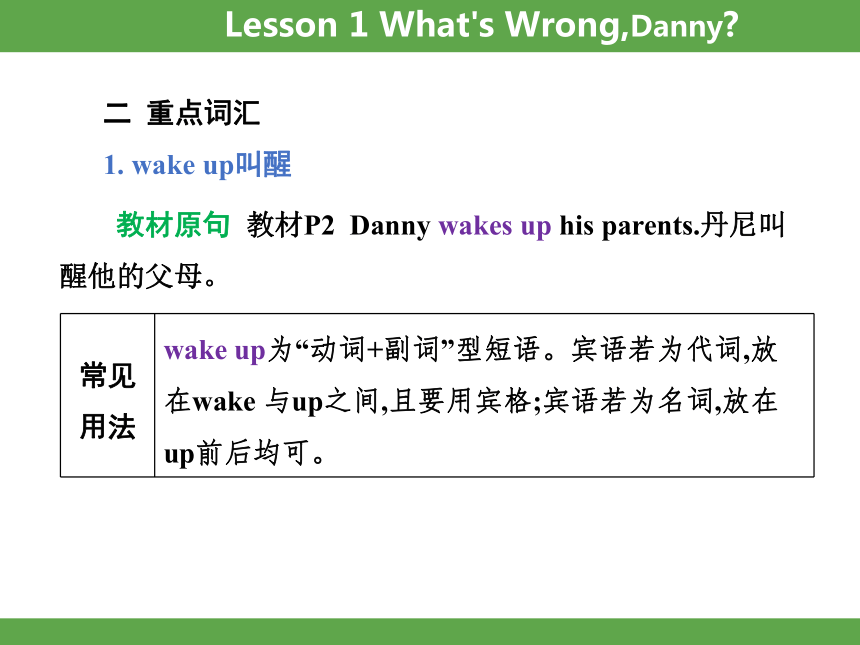
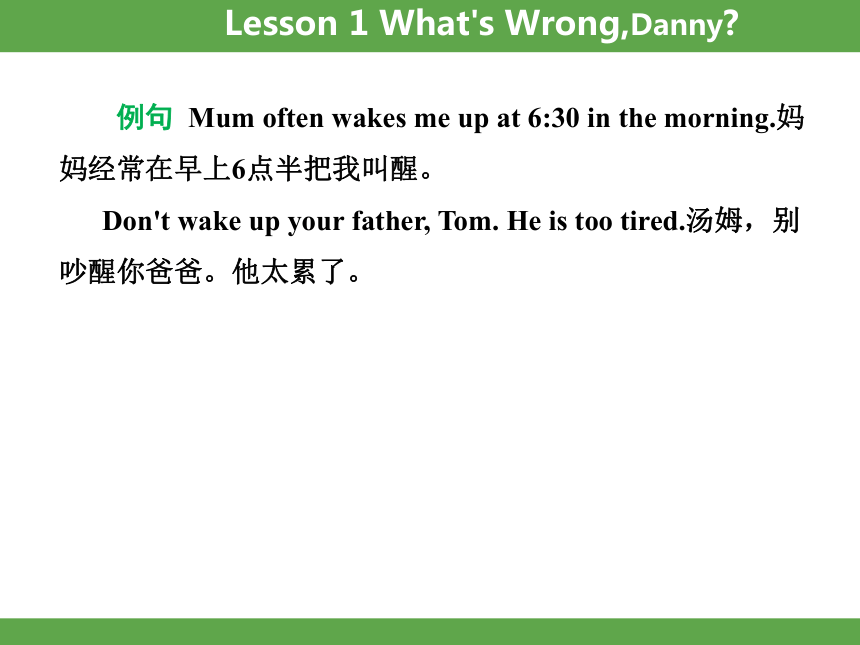
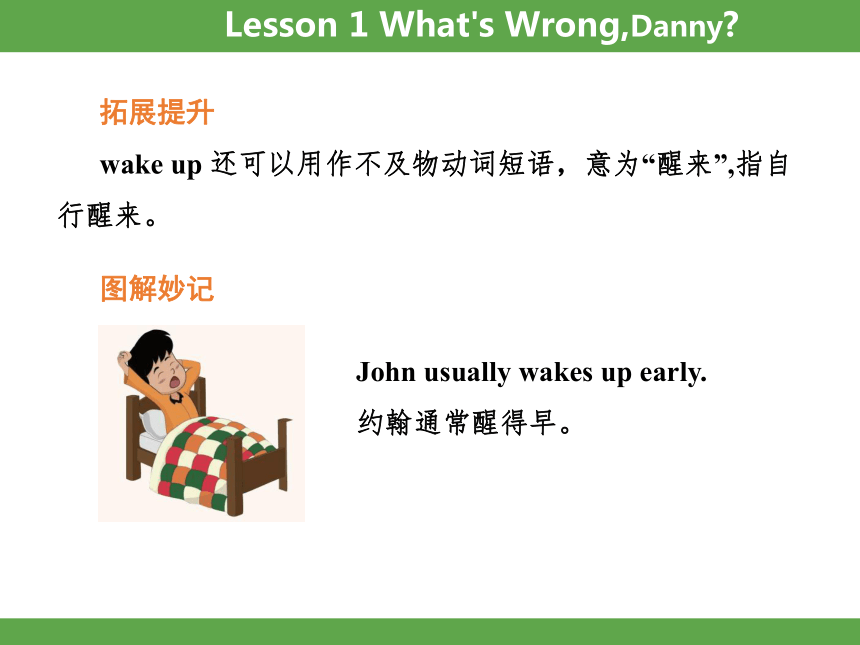
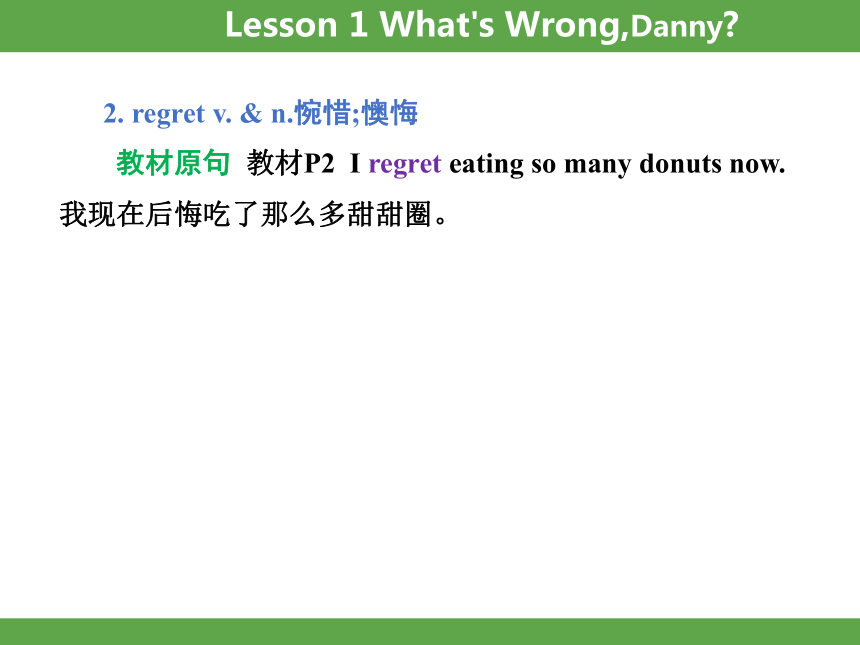
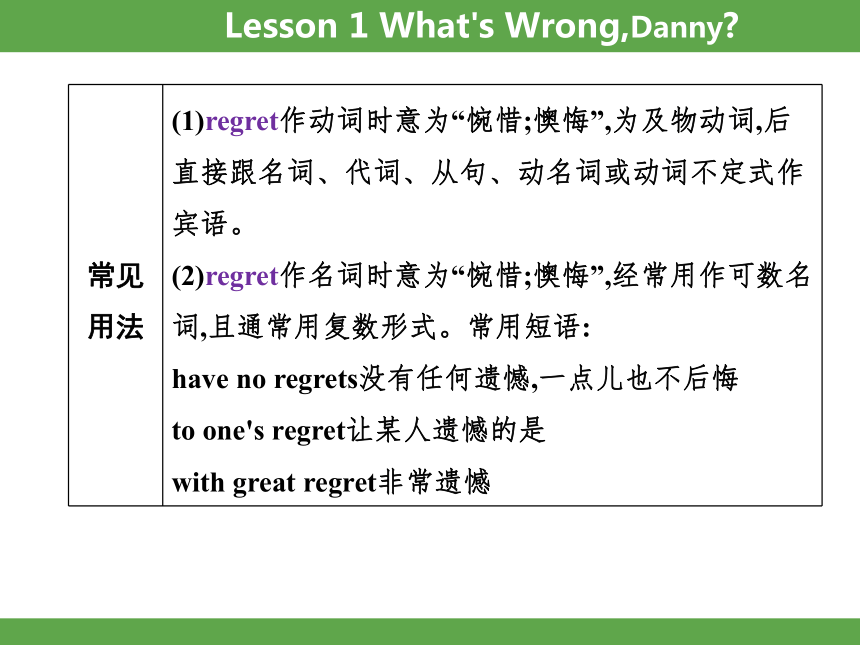
文档简介
(共98张PPT)
语
言
知识目
标
单元素养目标
词汇
话题
Stay Healthy(保持健康)
四会词
stomach; regret; fever; pale; examination; pain; pardon;X-ray; dentist;refuse; toothache; German; wolf; corn; bean; Asian; yogurt; diet; include;
smoke; harmful; disease; harm; public; law; whenever; risk; somebody;control; telephone; hers; cheer; kick; focus; pity; sleepy; mention
Unit 1 Stay Healthy
语
言
知识目
标
单元素养目标
词汇
非四
会词
rotten; fortunately; headset;
aching; grain; vitamin; mineral;
fibre; protein;soy; calcium; bone;
contain; balanced; lung; breathe;
cigarette; damage;unable; dare;
wheelchair; disabled; appendicitis;
appendix
Unit 1 Stay Healthy
重点
短语
regret doing..; get/ have a (high) fever;
get dressed; take an X-ray; go to the dentist;
have no choice but to do sth.; right away;
be rich in...; millions of; as a result of;
take a risk; get into the habit of...;
stay away from...; be unable to...; dare to...;
focus on; take out; now that; so that
语
言
知识目
标
单元素养目标
1. I don't feel well.
2. Need we go there right now
3. I've got a pain here.
4. What should we do
5. I'm really afraid of going to the dentist.
6. A balanced diet will keep you healthy and give you lots of energy!
7. If your family members smoke, encourage them to stop smoking.
重点
句型
Unit 1 Stay Healthy
语法
情态动词should,need的用法
Unit 1 Stay Healthy
语言能力目标
单元素养目标
单词:掌握本单元重点单词的音、形、义、性、用
短语:掌握本单元重点短语并能熟练造句
句型:掌握本单元重点句型,并能就本单元话题
熟练应用
语篇:·阅读看医生和谈论有关健康的语篇材料,
获取关键信息
·读懂看医生和谈论有关健康的文章
·能谈论有关健康的问题,并提出合理建议
表达:根据提示写如何保持健康的短文,
或给出合理的保持健康的建议
● 考点清单解读
一 单词背记及拓展
二 重点词汇
三 重点句式
Lesson 1 What's Wrong,Danny
Lesson 1 What's Wrong,Danny
一 单词背记及拓展
重点单词 词汇拓展
重 点 单 词 1. stomach n.胃;腹部 2. regret v.&n.惋惜;懊悔 3. fever n.发烧;发热 4. pale adj.苍白的;浅色的 5. examination n.检查;考试 6. pain n.疼痛 7. pardon v.& n.原谅 8.X-rayn.X光;X射线 1. stomach n.→stomachache(名词)胃痛;腹痛
2. regret v.→regretted (过去式)惋惜;懊悔
→regretted (过去分词)惋惜;懊悔
词汇拓展
重 点 单 词 3. examination n.→exam (缩略词)考试;测验;检查
4. pain n.→painful (形容词)痛苦的;疼痛的
熟词生义
pale 还可以用作动词,意为“变苍白;变白”。
Lesson 1 What's Wrong,Danny
二 重点词汇
1. wake up叫醒
教材原句 教材P2 Danny wakes up his parents.丹尼叫醒他的父母。
常见用法 wake up为“动词+副词”型短语。宾语若为代词,放在wake 与up之间,且要用宾格;宾语若为名词,放在up前后均可。
Lesson 1 What's Wrong,Danny
例句 Mum often wakes me up at 6:30 in the morning.妈妈经常在早上6点半把我叫醒。
Don't wake up your father, Tom. He is too tired.汤姆,别吵醒你爸爸。他太累了。
Lesson 1 What's Wrong,Danny
拓展提升
wake up 还可以用作不及物动词短语,意为“醒来”,指自行醒来。
图解妙记
John usually wakes up early.
约翰通常醒得早。
Lesson 1 What's Wrong,Danny
2. regret v. & n.惋惜;懊悔
教材原句 教材P2 I regret eating so many donuts now.我现在后悔吃了那么多甜甜圈。
Lesson 1 What's Wrong,Danny
常见用法 (1)regret作动词时意为“惋惜;懊悔”,为及物动词,后直接跟名词、代词、从句、动名词或动词不定式作宾语。
(2)regret作名词时意为“惋惜;懊悔”,经常用作可数名词,且通常用复数形式。常用短语:
have no regrets没有任何遗憾,一点儿也不后悔
to one's regret让某人遗憾的是
with great regret非常遗憾
Lesson 1 What's Wrong,Danny
例句 If you don't do it now, you'll regret it. 如果你现在不做,你会后悔的。
I deeply regret what I said.我对我所说的话深感后悔。
I have no regrets about my decision.对于我的决定,我毫不后悔。
Lesson 1 What's Wrong,Danny
易混辨析
易混短语 用法
regret to do sth. 表示对将要做的事情感到遗憾、抱歉,强调事情还没有做。
regret doing sth. 表示对做过的事情感到后悔,强调事情已经做了。
I regret to tell you that you didn't pass the exam.我很遗憾地告诉你,你没有通过考试。
I don't regret putting time and energy into the work.我不后悔为工作投入时间和精力。
Lesson 1 What's Wrong,Danny
3. get dressed 穿衣服
教材原句 教材P2 Danny’s father gets dressed quickly.丹尼的父亲迅速穿上衣服。
常见用法 get dressed 意为“穿衣服”,此处get为系动词,与形容词dressed 构成系表结构。
例句 Hurry up and get dressed!快点儿穿上衣服!
Lesson 1 What's Wrong,Danny
拓展提升
与dress 相关的其他常见表达:
(1)dress sb./ oneself给某人(自己)穿衣服
(2)dress up乔装打扮
(3)bedressed in穿着其宾语为衣服,强调状态。
Lesson 1 What's Wrong,Danny
三 重点句式
表达身体不适的句型
教材原句 教材P2 You've got a high fever, son.儿子,你发高烧了。
Lesson 1 What's Wrong,Danny
句式结构 表达身体疼痛或不舒服的句式结构:
(1)某人+have/ has a/ an+病症.
(2)某人+have/ has a sore+发病部位.
(3)某人+hurt(s)+身体部位或反身代词.
(4)某部位+hurt(s).
(5)某人+have/ has a pain in one's+身体部位.
(6)There is something wrong with one’s+身体部位.
Lesson 1 What's Wrong,Danny
例句 She had a stomachache last night.她昨晚胃痛。
He has a sore throat.他喉咙疼。
I have a pain in my chest.我胸口疼。
拓展提升
(1)get a (high) fever = have a (high) fever 发(高)烧。注意含have的短语强调状态,能与时间段连用;含get 的短语强调动作,不能与时间段连用。
(2)询问病情的问句:
What's wrong (with...)
=What's the matter (with...)
=What's the trouble (with...)
(某人/物)怎么了 /(某人/物)出什么事了
Lesson 1 What's Wrong,Danny
● 考点清单解读
一 单词背记及拓展
二 重点词汇
三 重点句式
Lesson 2 A Visit to the Dentist
Lesson 2 A Visit to the Dentist
一 单词背记及拓展
重点单词 词汇拓展
重 点 单 词 1. dentist n.牙医 2. refuse v.拒绝;回绝 3. toothache n.牙痛 4. fortunately adv.幸运地 5. aching adj.疼痛的 6. German adj.德国的 n.德国人;德语 7. wolf n.狼 1. refuse v.→refuses(第三人称单数)拒绝;回绝
→refused (过去式/过去分词)拒绝;回绝
2. toothache n.→tooth (名词) 牙齿
词汇拓展
重 点 单 词 3. fortunately adv. →unfortunately(反义词)不幸地
4. German n.→Germans(复数)德国人
→Germany(名词)德国
5. wolf n.→wolves(复数)狼
熟词生义
wolf作名词时,还可以意为“残忍凶狠的人”。
Lesson 2 A Visit to the Dentist
二 重点词汇
1. refuse v.拒绝;回绝
教材原句 教材P4 When my mum wants me to go to the dentist, I always refuse.当我妈妈想让我去看牙医时,我总是拒绝。
常见用法 refuse 既可以作及物动词,也可以作不及物动词,意为“拒绝;回绝”。搭配:refusesb./ sth.拒绝某人/某物;refuse to do sth.拒绝做某事。
Lesson 2 A Visit to the Dentist
例句 Mrs. Green refuses to eat sweet food. She doesn't want to get fat.格林夫人拒绝吃甜食。她不想变胖。
Lesson 2 A Visit to the Dentist
拓展提升
refuse 的 同义短语是 turn down,反义词是 accept。
图解妙记
Learn to refuse/turn down the
unreasonable request.
学会拒绝不合理的请求。
Lesson 2 A Visit to the Dentist
2. afraid adj.害怕的;担心的
教材原句 教材P4 I'm really afraid of going to the dentist. 我真的害怕去看牙医。
Lesson 2 A Visit to the Dentist
常见用法 afraid 用作形容词,意为“害怕的;担心的”,在句中通常作表语。主要用于以下结构:
(1)be afraid of sb./ sth.害怕某人/某物
(2)be afraid to do sth.不敢/害怕做某事
(3)be afraid of doing sth.害怕做某事
例句 Are you afraid of snakes 你怕蛇吗
The girl is afraid to go out alone at night.这个女孩害怕晚上独自出去。
Don't be afraid of asking questions.不要害怕问问题。
Lesson 2 A Visit to the Dentist
拓展提升
"I'm afraid not.意为“恐怕不能。”,是拒绝邀请的委婉表达。“I’m afraid so.”意为“恐怕是这样。”,表示肯定。“I’m afraid+从句.”意为“恐怕……”,表达不愿发生的事情。
如:——Can you come tonight 今晚你能来吗
——I'm afraid not.恐怕不能。
Lesson 2 A Visit to the Dentist
3. right away 立刻;马上
教材原句 教材P4 She saw right away that I was scared and told me not to worry.她立刻发觉我害怕并告诉我不要担心。
常见用法 right away 意为“立刻;马上”,主要用于美式英语,强调动作迅速。同义短语:at once。
例句 Please answer my question right away.请立刻回答我的问题。
My friend will come back right away.我的朋友马上就会回来的。
Lesson 2 A Visit to the Dentist
拓展提升
right now/ at the moment 意为“此刻;现在”。
如:Mr. Wu isn't in the office right now.吴先生现在不在办公室里。
Lesson 2 A Visit to the Dentist
易错提示
right away/ at once多用于祈使句或将来时中。
三 重点句式
1. one of...的用法
教材原句 教材P4 She thought that one of my teeth was probably rotten and that I needed to go to a dentist.她认为我的一颗牙齿可能坏了,我需要去看牙医。
Lesson 2 A Visit to the Dentist
常见用法 “one of+可数名词复数”意为“……中的一个”。该短语作主语时,谓语动词用单数形式。
例句 One of my questions is how to learn English well.我其中的一个问题是怎样学好英语。
拓展提升
在“one of+可数名词复数”短语中,如果名词前有形容词修饰,则用形容词的最高级形式,表示“最……的……之一”。如:The Yangtze River is one of the longest rivers in the world.长江是世界上最长的河流之一。
Lesson 2 A Visit to the Dentist
2. have no choice but to do sth.的用法
教材原句 教材P4 I had no choice but to go with her.我别无选择,只能跟她一起去。
Lesson 2 A Visit to the Dentist
常见用法 have no choice but to do sth.意为“除了做某事以外,别无选择/只好做某事”。
例句 What a heavy rain!We have no choice but to wait at the bus stop.多么大的雨啊!我们除了在公交车站等待没有别的选择。
易错提示
but 此处用作连词,意为“除了……”,后接不定式。若but 前有do的某种形式,but后常省略不定式符号to。
如:You can do nothing but let nature take its course.除了顺其自然,你什么也做不了。
Lesson 2 A Visit to the Dentist
● 考点清单解读
一 单词背记及拓展
二 重点词汇
Lesson 3 Good Food, Good Health
Lesson 3 Good Food, Good Health
一 单词背记及拓展
重点单词 词汇拓展
重 点 单 词 1. corn n.玉米 2. bean n.豆子 3. Asian adj.亚洲的n.亚洲人 4. include v.包括;包含 5. bone n.骨头;骨 6. contain v. 包含 7. balanced adj.均衡的 1. bean n.→beans (复数)豆子
2. Asian adj.&n.→Asia(名词) 亚洲
3. include v. →including(介词)包括;包含
Lesson 3 Good Food, Good Health
重点单词 词汇拓展
重 点 单 词 8. yogurt n.酸奶 9. diet n.日常饮食;日常食物 4. bone n.→bones(复数)骨头;骨
5. balanced adj.→balance (名词) 平衡;均衡
熟词生义
contain 作动词时,还可以意为“控制;阻止”。
二 重点词汇
1. include v.包括;包含
教材原句 教材P6 A well-balanced diet includes foods from each food group.一份均衡的饮食包括来自每一个食品种类的食物。
常见用法 include 为及物动词,意为“包括;包含”,指包括整体的一个部分或一些要素。一般不用于进行时态,后可跟名词、代词或动名词作宾语。
Lesson 3 Good Food, Good Health
例句 The price of the room includes breakfast.房间的价格中包括早餐费。
Your duties include typing letters and answering the telephone.你的职责包括打字和接电话。
Lesson 3 Good Food, Good Health
易混辨析
include与contain
Lesson 3 Good Food, Good Health
易混词 用法及例句
include 宾语只能为全部内容的部分内容或容量。如:Her hobbies include music and painting.她的爱好包括音乐和绘画。
contain 宾语可以是全部内容或容量,也可以是其部分内容或容量。如:This book contains six parts. 这本书包含六个部分。
2. be made 短语
教材原句 教材P6 Breakfast cereal is also made of different grains.早餐麦片也是由不同的谷物制成的。
常见用法 be made 后跟不同的介词,表达不同的含义。常见结构如下:
(1)be made of 由……制成(从制成品中可以看出原材料);
(2)be made from由……制成(从制成品上看不出原材料);
(3)be made in在……被制造(后接地点名词);
Lesson 3 Good Food, Good Health
常见用法 (4)be made by由(某人或某方式)制成;
(5)be made into被制成……(后接成品);
(6)be made up of 由……组成(of后接组成的部分)。
Lesson 3 Good Food, Good Health
例句 Look! The box is made of wood. As we all know, paper is made from wood.看!这个盒子是由木头制成的。众所周知,纸是由木头制成的。
小助记
be made 短语
Our dinner is made by Dad. It’s made up of three parts. Salad is made of vegetables. Cheese is made from milk and bread is made in Handan. They can be made into sandwiches. 我们的晚餐是爸爸做的。 它由三部分组成。沙拉是用蔬菜做的。奶酪是用牛奶做的,面包产自邯郸。 它们可以被做成三明治。
Lesson 3 Good Food, Good Health
● 考点清单解读
一 单词背记及拓展
二 重点词汇
三 重点句式
Lesson 4 Don’t Smoke, Please!
Lesson 4 Don’t Smoke, Please!
一 单词背记及拓展
重点单词 词汇拓展
重 点 单 词 1. smoke v. 吸烟 n. 烟 2. harmful adj.(尤指对健康或环境)有害的; 导致损害的 3. public adj. 公共的;大众的 4. law n. 法律;法规 1. smoke v. →smoking (现在分词)吸烟
→smoked (过去式/过去分词)吸烟
2. harmful adj.→harm (动词/名词)伤害;损害
3. risk n.→risks(复数)危险;风险
Lesson 4 Don’t Smoke, Please!
重点单词 词汇拓展
重 点 单 词 5. whenever conj. 在任何……的时候;无论何时 6. risk n. 危险;风险 7. somebody pron. 有人;某人 8. disease n. 病;疾病 9. harm v. & n. 伤害;损害 10. breathe v. 呼吸 4. disease n.→illness(同义词)疾病
5. breathe v.→breath(名词)呼吸;气息
6. somebody pron.→someone (同义词) 有人;某人
Lesson 4 Don’t Smoke, Please!
熟词生义
重点 单词 somebody 作名词时,可以意为“大人物,重要人物”。
二 重点词汇
1. harmful adj.(尤指对健康或环境)有害的;导致损害的
教材原句 教材P8 Why is smoking harmful 吸烟为什么是有害的?
常见用法 harmful 为形容词,常用短语 be harmful to sb./ sth.意为“对某人/物有害”。 反义词:harmless 无害的;同义短语:be bad for;反义短语:be good for。
Lesson 4 Don’t Smoke, Please!
例句 Plastic bags are really harmful to our environment. 塑料袋对我们的环境确实有害。
Trees are good for our health because they take in harmful gases. 树木对我们的健康有益,因为它们吸收有害气体。
Lesson 4 Don’t Smoke, Please!
拓展提升
harmful是由harm加形容词后缀-ful 构成。
(1)harm 作名词,意为“伤害;损 害”。 do harm to... 意为“对……有害”,相 当 于 be harmful to...。 如:Controlling the children too much does harm to them.
过多地控制孩子对他们有害。
(2)harm 作动词时,harm oneself 与 hurt oneself 同义。
Lesson 4 Don’t Smoke, Please!
2. risk n. 危险;风险
教材原句 教材P8 Don’t take that risk. 不要冒那个险。
常见用法 risk 作名词,意为“危险;风险”。 常用短语:
(1)the risk of... ……的危险/风险
(2)the risk to... 对……的危险
(3)take a risk/ risks 冒险
(4)at the risk of doing sth. 冒着做某事的风险
Lesson 4 Don’t Smoke, Please!
例句 Healthy eating can reduce the risk of heart disease. 健康的饮食能减少患心脏病的危险。
拓展提升
risk 用作及物动词时,意为“冒险做”,后接名词、代词或动名词形式作宾语。 如:
If you put all your eggs in one basket, you risk losing everything all at one time.
如果你把所有的鸡蛋放在一个篮子里,你可能会一下子失去所有的东西。
Lesson 4 Don’t Smoke, Please!
3. millions of 数以百万计的
教材原句 教材P8 Every year, millions of people around the world die as a result of smoking. 每年,世界上有数百万的人死于吸烟。
常见用法 millions of 意为“数以百万计的”,表示约数,其后接可数名词的复数形式。
Lesson 4 Don’t Smoke, Please!
例句 There are millions of living things on the earth. We must care for our home — the earth. 地球上有数以百万计的生物, 我们必须爱护我们的家园———地球。
拓展提升
(1)当 million 前有不定冠词 a 或基数词修饰时,不能用复数形式,也不能与 of 连用。 如:five million 五百万
(2)hundred(百), thousand(千)的用法与 million 相同。
Lesson 4 Don’t Smoke, Please!
三 重点句式
1. 动名词(短语)作主语
教材原句 教材P8 Smoking is bad for your health. 吸烟对你的健康有害。
常见用法 在一般现在时的句子中,当一个动名词(短语)作主语时,谓语动词用第三人称单数形式;当两个及两个以上的动名词(短语)作主语时,实义动词用原形,be 动词用 are。
Lesson 4 Don’t Smoke, Please!
例句 Eating fresh vegetables is good for our health. 吃新鲜的蔬菜对我们的健康有好处。
Having a balanced diet and doing exercise make you lose weight. 均衡饮食和运动有助于你减肥。
Lesson 4 Don’t Smoke, Please!
拓展提升
动名词(短语)作主语时可改为用动词不定式(短语)作主语,此时常用 it作形式主语,而将真正的主语———动词不定式(短语)放在句末,即“It is/ was+形容词或名词+to do sth.”。 如:Learning maths well isn’t difficult. = It’s not difficult to learn maths well. 学好数学并不难。
Lesson 4 Don’t Smoke, Please!
2. whenever 引导的让步状语从句
教材原句 教材P8 Whenever someone offers you a cigarette, you should always say no. 无论什么时候有人给你香烟,你都应该拒绝。
常见用法 whenever 是连词,在此处引导让步状语从句,意为“无论何时”,相当于 no matter when。
Lesson 4 Don’t Smoke, Please!
例句 You can ask for help whenever you need it. 你无论何时需要帮助,都可以提出来。
拓展提升
引导让步状语从句时,“疑问词+-ever”相当于“no matter+疑问词”。 如:whatever = no matter what 无论什么;wherever = no matter where 无论哪里
Lesson 4 Don’t Smoke, Please!
● 考点清单解读
一 单词背记及拓展
二 重点词汇
三 重点句式
Lesson 5 Jane’s Lucky Life
Lesson 5 Jane’s Lucky Life
一 单词背记及拓展
重点单词 词汇拓展
重 点 单 词 1. control v. 控制;管理;支配 2. telephone n. 电话;电话机 3. hers pron. 她的 1. control v. →controlling (现在分词) 控制;管理;支配
2. telephone n. →phone (同义词) 电话;电话机
3. hers pron. →she (主格) 她/ her (宾格) 她
Lesson 5 Jane’s Lucky Life
重点单词 词汇拓展
重 点 单 词 4. cheer v.欢呼;喝彩;加油 n.欢呼声;喝彩声 5. kick v.踢 6. pity n. 同情,怜悯;遗憾 7. unable adj.不能的 8. damage v.损害;损坏 9.dare v.敢;敢于;挑战 4. cheer v. →cheerful (形容词)高兴的;快乐的
→cheerfully(副词)高兴地;快乐地
5. kick v. →kicked (过去式/过去分词)踢
→kicks (第三人称单数)踢
6. unable adj.→able (反义词)能够的;有能力的
Lesson 5 Jane’s Lucky Life
重点单词 熟词生义
重 点 单 词 10. disabled adj.肢体有残疾的 11. focus v.集中;聚集n.焦点 damage 作名词时,意为“损害;伤害;赔偿金”。
二 重点词汇
1. control v. 控制;管理;支配
教材原句 教材P10 She controls her wheelchair with her mouth. 她用嘴控制轮椅。
常见用法 control 多用作及物动词,意为“控制;管理;支配”,后面常接名词或代词作宾语。
Lesson 5 Jane’s Lucky Life
例句 The firemen successfully controlled the fire. 消防员成功地控制住了火势。
拓展提升
control 还可以作名词,意为“管理;控制”。 常用搭配:
in control 控制;掌管
under control 处于控制之下
out of control 失去控制
如:The car was out of control and hit a tree by the road. 汽车失去控制了,撞到了路边的一棵树上。
Lesson 5 Jane’s Lucky Life
2. pity n. 同情,怜悯;遗憾
教材原句 教材P10 I don’t need any pity. 我不需要任何同情。
常见用法 pity 为不可数名词时,意为“同情,怜悯”,其后常接介词 for/ on。
Lesson 5 Jane’s Lucky Life
例句 I took pity on him and lent him the money. 我同情他,就把钱借给了他。
拓展提升
pity 表示“遗憾的事;可惜的事”,为可数名词。
常用句型有:
(1)What a pity! 真可惜!
(2)It’s a pity that... …… 真可惜。
(3)It’s a pity for sb. to do sth.对某人来说,做某事很遗憾。
Lesson 5 Jane’s Lucky Life
三 重点句式
1. be unable to 的用法
教材原句 教材P10 She is unable to do many things. 她不能做很多事情。
常见用法 be unable to do sth.意为“不能做某事”,与 be not able to do sth.同义。 unable 为形容词,意为“不能的;不会的”。 反义短语为 be able to do sth.。
Lesson 5 Jane’s Lucky Life
例句 Sandy was unable to move the heavy box. She had to ask her father for help. 桑迪搬不动那个重箱子。 她不得不向父亲求助。
Lesson 5 Jane’s Lucky Life
拓展提升
unable 是 由 否定前缀 un-和形容词 able 构成的。 类似的词还有:
unhappy 不快乐的
unfriendly 不友好的
unfortunate 不幸的
unclear 不清楚的
Lesson 5 Jane’s Lucky Life
2. be married 的用法
教材原句 教材P8 Jane is married and has two children. 简结婚了,有两个孩子。
常见用法 be married 意为“结婚”,强调状态,可以和时间段连用。 表示“和某人结婚”用 be married to sb.(表状态)或 marry sb.。
Lesson 5 Jane’s Lucky Life
例句 She has been married to a doctor for two years. 她已经和一个医生结婚两年了。
易错提示
get married 也表示“结婚”,强调动作,不可以和时间段连用。如:Lucy and Peter got married last week. 露西和彼得上周结婚了。
Lesson 5 Jane’s Lucky Life
Lesson 6 Stay Away from the Hospital
● 考点清单解读
一 单词背记及拓展
二 重点词汇
三 重点句式
一 单词背记及拓展
重点单词 词汇拓展
重 点 单 词 1. sleepy adj. 困倦的,瞌 睡的 2. mention v. 提到;写到 (某人或某事) 1. sleepy adj. →sleep (动词/名词) 睡觉;睡眠
→asleep (形容词) 睡着的
→sleeping (现在分词) 睡觉
2. mention v. →mentioned (过去式) 提到;写到(某人或某事)
Lesson 6 Stay Away from the Hospital
二 重点词汇
1. sleepy adj. 困倦的,瞌睡的
教材原句 教材P10 The next day, when I woke up, I felt terrible and very sleepy. 第二天,当我醒来的时候,我感到难受而且非常困倦。
常见用法 sleepy 作形容词,意为“困倦的,瞌睡的”,在句中作表语或定语,强调状态。 搭配:feel sleepy 感到困倦。
例句 Working for long hours made the man feel sleepy. 长时间的工作使这个人感到困倦。
Lesson 6 Stay Away from the Hospital
易混辨析
其他与“睡眠”相关的词汇辨析:
(1)sleep 作动词或名词,意为“睡觉”。 搭配:go to sleep 去睡觉。
(2)asleep 作形容词,意为“睡着的”,不可作定语,在句中常用作表语。 搭配:fall asleep 入睡;睡着。
Lesson 6 Stay Away from the Hospital
2. take out 切除;摘除;带走
教材原句 教材P12 The doctor took it out! 医生把它(阑尾)切除了!
常见用法 take out 为“动词+副词”型短语,当宾语为代词时,代词只能放在两词之间;当宾语为名词时,名词放在 out 前后均可。
例句 I take out a skipping rope and do exercise. 我拿出一根跳绳做运动。
Lesson 6 Stay Away from the Hospital
拓展提升
含 take 的 其 他常见短语:
take off 起飞;脱下
take up 占据;开始从事
take down 写下;记录
take on 承担;呈现
take away 拿走;消除
Lesson 6 Stay Away from the Hospital
3. mention v. 提到;写到(某人或某事)
教材原句 教材P12 Now that you mention it, Wang Mei also had a bad day. 既然你提到此事,王梅也经历了糟糕的一天。
常见用法 mention 为及物动词,后常接名词、代词、动名词或 that/ wh-从句。 常用结构:mention sth. to sb. 向某人提到某事。
例句 I mentioned this idea to Susan, and she seemed to like it. 我向苏珊提过这个想法,她似乎很喜欢。
Lesson 6 Stay Away from the Hospital
拓展提升
Don’t mention it.可用于回答别人的道谢,意为“不用谢;不客气”。 如:
—Thanks for giving me a ride!谢谢你带了我一程。
—Don’t mention it. 不客气。
Lesson 6 Stay Away from the Hospital
4. plenty of 很多的;大量的
教材原句 教材P12 She told me to drink plenty of water and have a good rest. 她告诉我多喝水,并好好休息。
常见用法 plenty of 意为“很多的;大量的”,既能修饰可数名词复数,又能修饰不可数名词,相当于 a lot of 和 lots of,通常用于肯定句中(在疑问句和否定句中主要用 many 和 much)。
例句 There are plenty of books in the library. 图书馆里有大量的书。
Lesson 6 Stay Away from the Hospital
易错提示
“plenty of+名词”作主语时,谓语动词的数要与后面的名词在人称和数上保持一致。 如:
Plenty of snow has melted since the sun came out. 太阳出来后,大量的雪融化了。
Lesson 6 Stay Away from the Hospital
三 重点句式
so that 的用法
教材原句 教材P12 I think we should try hard to form good habits so that we can stay healthy and stay away from the hospital! 我认为我们应该努力养成好习惯,以便我们可以保持健康、远离医院!
常见用法 so that 意为“为了;以便;目的是”,用来引导目的状语从句,从句中常使用 can, could, may, might 等情态动词。
Lesson 6 Stay Away from the Hospital
例句 We set out early so that we can arrive on time. 我们早早地出发以便我们能按时到达。
Let’s take the simple steps today so that we will save the world for our grandsons and granddaughters tomorrow. 让我们从今天开始采取一些简单的措施吧,这样我们将会为我们的后代子孙拯救世界。
Lesson 6 Stay Away from the Hospital
拓展提升
(1)so that 还可以用来引导结果状语从句,意为“结果;以致;因此”。 如:
She got up early so that she caught the first train. 她很早起床,因此赶上了第一班火车。
(2)so... that...用来引导结果状语从句,意为“如此……以至于……”,so 后接形容词或副词原级。 如:
WiFi is so useful that people can surf online anytime and anywhere. WiFi 如此有用,以至于人们可以随时随地上网。
Lesson 6 Stay Away from the Hospital
四 重点语法
情态动词 should, need
(一)情态动词 should 的用法
教材原句 教材P2 We should go to the hospital. 我们应该去医院。
常见用法 should 作情态动词时,无人称和数的变化,后接动词原形。其变否定形式时,直接在 should 后加 not,可缩写为 shouldn’t,意为“不应该”。变一般疑问句时,should 提至句首。具体用法如下:
Lesson 6 Stay Away from the Hospital
例句 You should keep quiet in the cinema. 在电影院你应该保持安静。
1. 表示劝告或建议,意为“应该;应当”。
2. 表示责任、义务,意为“应该;应当”。
例句 You should help your mother with the housework. 你应该帮助你母亲做家务。
3. 表示征求同意或征询意见时,通常用于主语为第一人称的疑问句。
例句 When should we have lunch 我们应该什么时候吃午饭?
Lesson 6 Stay Away from the Hospital
拓展提升
should 的 句 式结构:
肯定句:sb. +should +动词原形+其他.
否定句:sb.+shouldn’t+动词原形+其他.
一般疑问句:Should sb.+动词原形+其他
如 :People shouldn’t talk on a mobile phone while driving.开车期间人们不应该用手机通话。
Lesson 6 Stay Away from the Hospital
(二)情态动词 need 的用法
教材原句 教材P2 Need we go there right now 我们需要马上去那儿吗?
教材P4 You needn’t be afraid. 你不必害怕。
常见用法 need 作情态动词时表示“需要”,无人称和数的变化,后接动词原形, 主要用于否定句和疑问句中。 其否定形式为needn’t,意为“没有必要,不必”。 用 need 提问时,肯定回答一般用 must 或 have to ,否定回答一般用 needn’t 或 don’t have to。
Lesson 6 Stay Away from the Hospital
例句 —Need I go with him 我需要和他一起去吗?
—Yes, you must. 是的,你必须去。 / No, you needn’t. 不,你不必去。
Lesson 6 Stay Away from the Hospital
拓展提升
need 作 实 义 动词时,意为“需要”,常用于肯定句,有人称和数的变化。主要用法:
(1)need sth./ sb. 需要某物/某人;
(2)need to do sth. 需要做某事;
(3)(sth.) need(s) doing =(sth.)need(s) to be done(某事)需要被做。 如:
Sally’s parents are away, so she needs to cook for herself.
莎莉的父母不在家,所以她需要自己做饭。
Lesson 6 Stay Away from the Hospital
语篇考法精讲
推断文章体裁题解题技巧
典例剖析
St. Glory Hospital
Patient’s Name: Lucy Johnson
Date: May 16
To whom it may concern,
The patient above was examined, treated and allowed to leave our hospital on May 15. It is my suggestion that she should take one day off from work on May 16. Drinking a lot of water, keeping a light diet and having a good sleep are also strongly suggested.
语篇考法精讲
Sincerely,
Doctor Mark Palmer
St. Glory Hospital
Mark Palmer
St. Glory Hospital
1236 S. Shelby St., Louisville, KY 40203
续表
语篇考法精讲
[中考新考法·推断文章体裁]
What kind of writing is the text
A. A sick leave note.
B. A news report.
C. A safety guide.
D. A hospital ad.
语篇考法精讲
[解析]根 据 文 中“The patient above was examined, treated and allowed to leave our hospital on May 15. It is my suggestion that she should take one day off from work on May 16.(上述患者于 5 月 15 日接受检查、治疗并获准出院。 我建议她在5 月 16 日请一天假。 )”可推知,这篇文章是一份病假单。 故选 A。
[答案] A
语篇考法精讲
考法说明
《课程标准(2022年版)》对语言技能内容提出如下要求,“根据不同目的,运用各种阅读策略有效获取语篇信息”。文章体裁题要求学生根据文章的内容、形式、语言特点及其关键词推断文章是属于邮件、诗歌、采访、广告、新闻报道等哪种文体。
语篇考法精讲
技巧点拨
解答此类试题时,一般有以下几种方法:
(1)有特定的书信/邮件格式 :letter/ e-mail;
(2)结构明显,韵律清晰,对仗工整:poem;
(3)有写作日期、天气,记录实践或感受:diary;
(4)介绍新产品、新影片、演出等:poster/ ad;
(5)通篇对话:novel;
语篇考法精讲
(6)出自某个网页会有website(网站),click(点击);
(7)有极强的时效性或带消息来源、有导语:news/ newsreport。
语
言
知识目
标
单元素养目标
词汇
话题
Stay Healthy(保持健康)
四会词
stomach; regret; fever; pale; examination; pain; pardon;X-ray; dentist;refuse; toothache; German; wolf; corn; bean; Asian; yogurt; diet; include;
smoke; harmful; disease; harm; public; law; whenever; risk; somebody;control; telephone; hers; cheer; kick; focus; pity; sleepy; mention
Unit 1 Stay Healthy
语
言
知识目
标
单元素养目标
词汇
非四
会词
rotten; fortunately; headset;
aching; grain; vitamin; mineral;
fibre; protein;soy; calcium; bone;
contain; balanced; lung; breathe;
cigarette; damage;unable; dare;
wheelchair; disabled; appendicitis;
appendix
Unit 1 Stay Healthy
重点
短语
regret doing..; get/ have a (high) fever;
get dressed; take an X-ray; go to the dentist;
have no choice but to do sth.; right away;
be rich in...; millions of; as a result of;
take a risk; get into the habit of...;
stay away from...; be unable to...; dare to...;
focus on; take out; now that; so that
语
言
知识目
标
单元素养目标
1. I don't feel well.
2. Need we go there right now
3. I've got a pain here.
4. What should we do
5. I'm really afraid of going to the dentist.
6. A balanced diet will keep you healthy and give you lots of energy!
7. If your family members smoke, encourage them to stop smoking.
重点
句型
Unit 1 Stay Healthy
语法
情态动词should,need的用法
Unit 1 Stay Healthy
语言能力目标
单元素养目标
单词:掌握本单元重点单词的音、形、义、性、用
短语:掌握本单元重点短语并能熟练造句
句型:掌握本单元重点句型,并能就本单元话题
熟练应用
语篇:·阅读看医生和谈论有关健康的语篇材料,
获取关键信息
·读懂看医生和谈论有关健康的文章
·能谈论有关健康的问题,并提出合理建议
表达:根据提示写如何保持健康的短文,
或给出合理的保持健康的建议
● 考点清单解读
一 单词背记及拓展
二 重点词汇
三 重点句式
Lesson 1 What's Wrong,Danny
Lesson 1 What's Wrong,Danny
一 单词背记及拓展
重点单词 词汇拓展
重 点 单 词 1. stomach n.胃;腹部 2. regret v.&n.惋惜;懊悔 3. fever n.发烧;发热 4. pale adj.苍白的;浅色的 5. examination n.检查;考试 6. pain n.疼痛 7. pardon v.& n.原谅 8.X-rayn.X光;X射线 1. stomach n.→stomachache(名词)胃痛;腹痛
2. regret v.→regretted (过去式)惋惜;懊悔
→regretted (过去分词)惋惜;懊悔
词汇拓展
重 点 单 词 3. examination n.→exam (缩略词)考试;测验;检查
4. pain n.→painful (形容词)痛苦的;疼痛的
熟词生义
pale 还可以用作动词,意为“变苍白;变白”。
Lesson 1 What's Wrong,Danny
二 重点词汇
1. wake up叫醒
教材原句 教材P2 Danny wakes up his parents.丹尼叫醒他的父母。
常见用法 wake up为“动词+副词”型短语。宾语若为代词,放在wake 与up之间,且要用宾格;宾语若为名词,放在up前后均可。
Lesson 1 What's Wrong,Danny
例句 Mum often wakes me up at 6:30 in the morning.妈妈经常在早上6点半把我叫醒。
Don't wake up your father, Tom. He is too tired.汤姆,别吵醒你爸爸。他太累了。
Lesson 1 What's Wrong,Danny
拓展提升
wake up 还可以用作不及物动词短语,意为“醒来”,指自行醒来。
图解妙记
John usually wakes up early.
约翰通常醒得早。
Lesson 1 What's Wrong,Danny
2. regret v. & n.惋惜;懊悔
教材原句 教材P2 I regret eating so many donuts now.我现在后悔吃了那么多甜甜圈。
Lesson 1 What's Wrong,Danny
常见用法 (1)regret作动词时意为“惋惜;懊悔”,为及物动词,后直接跟名词、代词、从句、动名词或动词不定式作宾语。
(2)regret作名词时意为“惋惜;懊悔”,经常用作可数名词,且通常用复数形式。常用短语:
have no regrets没有任何遗憾,一点儿也不后悔
to one's regret让某人遗憾的是
with great regret非常遗憾
Lesson 1 What's Wrong,Danny
例句 If you don't do it now, you'll regret it. 如果你现在不做,你会后悔的。
I deeply regret what I said.我对我所说的话深感后悔。
I have no regrets about my decision.对于我的决定,我毫不后悔。
Lesson 1 What's Wrong,Danny
易混辨析
易混短语 用法
regret to do sth. 表示对将要做的事情感到遗憾、抱歉,强调事情还没有做。
regret doing sth. 表示对做过的事情感到后悔,强调事情已经做了。
I regret to tell you that you didn't pass the exam.我很遗憾地告诉你,你没有通过考试。
I don't regret putting time and energy into the work.我不后悔为工作投入时间和精力。
Lesson 1 What's Wrong,Danny
3. get dressed 穿衣服
教材原句 教材P2 Danny’s father gets dressed quickly.丹尼的父亲迅速穿上衣服。
常见用法 get dressed 意为“穿衣服”,此处get为系动词,与形容词dressed 构成系表结构。
例句 Hurry up and get dressed!快点儿穿上衣服!
Lesson 1 What's Wrong,Danny
拓展提升
与dress 相关的其他常见表达:
(1)dress sb./ oneself给某人(自己)穿衣服
(2)dress up乔装打扮
(3)bedressed in穿着其宾语为衣服,强调状态。
Lesson 1 What's Wrong,Danny
三 重点句式
表达身体不适的句型
教材原句 教材P2 You've got a high fever, son.儿子,你发高烧了。
Lesson 1 What's Wrong,Danny
句式结构 表达身体疼痛或不舒服的句式结构:
(1)某人+have/ has a/ an+病症.
(2)某人+have/ has a sore+发病部位.
(3)某人+hurt(s)+身体部位或反身代词.
(4)某部位+hurt(s).
(5)某人+have/ has a pain in one's+身体部位.
(6)There is something wrong with one’s+身体部位.
Lesson 1 What's Wrong,Danny
例句 She had a stomachache last night.她昨晚胃痛。
He has a sore throat.他喉咙疼。
I have a pain in my chest.我胸口疼。
拓展提升
(1)get a (high) fever = have a (high) fever 发(高)烧。注意含have的短语强调状态,能与时间段连用;含get 的短语强调动作,不能与时间段连用。
(2)询问病情的问句:
What's wrong (with...)
=What's the matter (with...)
=What's the trouble (with...)
(某人/物)怎么了 /(某人/物)出什么事了
Lesson 1 What's Wrong,Danny
● 考点清单解读
一 单词背记及拓展
二 重点词汇
三 重点句式
Lesson 2 A Visit to the Dentist
Lesson 2 A Visit to the Dentist
一 单词背记及拓展
重点单词 词汇拓展
重 点 单 词 1. dentist n.牙医 2. refuse v.拒绝;回绝 3. toothache n.牙痛 4. fortunately adv.幸运地 5. aching adj.疼痛的 6. German adj.德国的 n.德国人;德语 7. wolf n.狼 1. refuse v.→refuses(第三人称单数)拒绝;回绝
→refused (过去式/过去分词)拒绝;回绝
2. toothache n.→tooth (名词) 牙齿
词汇拓展
重 点 单 词 3. fortunately adv. →unfortunately(反义词)不幸地
4. German n.→Germans(复数)德国人
→Germany(名词)德国
5. wolf n.→wolves(复数)狼
熟词生义
wolf作名词时,还可以意为“残忍凶狠的人”。
Lesson 2 A Visit to the Dentist
二 重点词汇
1. refuse v.拒绝;回绝
教材原句 教材P4 When my mum wants me to go to the dentist, I always refuse.当我妈妈想让我去看牙医时,我总是拒绝。
常见用法 refuse 既可以作及物动词,也可以作不及物动词,意为“拒绝;回绝”。搭配:refusesb./ sth.拒绝某人/某物;refuse to do sth.拒绝做某事。
Lesson 2 A Visit to the Dentist
例句 Mrs. Green refuses to eat sweet food. She doesn't want to get fat.格林夫人拒绝吃甜食。她不想变胖。
Lesson 2 A Visit to the Dentist
拓展提升
refuse 的 同义短语是 turn down,反义词是 accept。
图解妙记
Learn to refuse/turn down the
unreasonable request.
学会拒绝不合理的请求。
Lesson 2 A Visit to the Dentist
2. afraid adj.害怕的;担心的
教材原句 教材P4 I'm really afraid of going to the dentist. 我真的害怕去看牙医。
Lesson 2 A Visit to the Dentist
常见用法 afraid 用作形容词,意为“害怕的;担心的”,在句中通常作表语。主要用于以下结构:
(1)be afraid of sb./ sth.害怕某人/某物
(2)be afraid to do sth.不敢/害怕做某事
(3)be afraid of doing sth.害怕做某事
例句 Are you afraid of snakes 你怕蛇吗
The girl is afraid to go out alone at night.这个女孩害怕晚上独自出去。
Don't be afraid of asking questions.不要害怕问问题。
Lesson 2 A Visit to the Dentist
拓展提升
"I'm afraid not.意为“恐怕不能。”,是拒绝邀请的委婉表达。“I’m afraid so.”意为“恐怕是这样。”,表示肯定。“I’m afraid+从句.”意为“恐怕……”,表达不愿发生的事情。
如:——Can you come tonight 今晚你能来吗
——I'm afraid not.恐怕不能。
Lesson 2 A Visit to the Dentist
3. right away 立刻;马上
教材原句 教材P4 She saw right away that I was scared and told me not to worry.她立刻发觉我害怕并告诉我不要担心。
常见用法 right away 意为“立刻;马上”,主要用于美式英语,强调动作迅速。同义短语:at once。
例句 Please answer my question right away.请立刻回答我的问题。
My friend will come back right away.我的朋友马上就会回来的。
Lesson 2 A Visit to the Dentist
拓展提升
right now/ at the moment 意为“此刻;现在”。
如:Mr. Wu isn't in the office right now.吴先生现在不在办公室里。
Lesson 2 A Visit to the Dentist
易错提示
right away/ at once多用于祈使句或将来时中。
三 重点句式
1. one of...的用法
教材原句 教材P4 She thought that one of my teeth was probably rotten and that I needed to go to a dentist.她认为我的一颗牙齿可能坏了,我需要去看牙医。
Lesson 2 A Visit to the Dentist
常见用法 “one of+可数名词复数”意为“……中的一个”。该短语作主语时,谓语动词用单数形式。
例句 One of my questions is how to learn English well.我其中的一个问题是怎样学好英语。
拓展提升
在“one of+可数名词复数”短语中,如果名词前有形容词修饰,则用形容词的最高级形式,表示“最……的……之一”。如:The Yangtze River is one of the longest rivers in the world.长江是世界上最长的河流之一。
Lesson 2 A Visit to the Dentist
2. have no choice but to do sth.的用法
教材原句 教材P4 I had no choice but to go with her.我别无选择,只能跟她一起去。
Lesson 2 A Visit to the Dentist
常见用法 have no choice but to do sth.意为“除了做某事以外,别无选择/只好做某事”。
例句 What a heavy rain!We have no choice but to wait at the bus stop.多么大的雨啊!我们除了在公交车站等待没有别的选择。
易错提示
but 此处用作连词,意为“除了……”,后接不定式。若but 前有do的某种形式,but后常省略不定式符号to。
如:You can do nothing but let nature take its course.除了顺其自然,你什么也做不了。
Lesson 2 A Visit to the Dentist
● 考点清单解读
一 单词背记及拓展
二 重点词汇
Lesson 3 Good Food, Good Health
Lesson 3 Good Food, Good Health
一 单词背记及拓展
重点单词 词汇拓展
重 点 单 词 1. corn n.玉米 2. bean n.豆子 3. Asian adj.亚洲的n.亚洲人 4. include v.包括;包含 5. bone n.骨头;骨 6. contain v. 包含 7. balanced adj.均衡的 1. bean n.→beans (复数)豆子
2. Asian adj.&n.→Asia(名词) 亚洲
3. include v. →including(介词)包括;包含
Lesson 3 Good Food, Good Health
重点单词 词汇拓展
重 点 单 词 8. yogurt n.酸奶 9. diet n.日常饮食;日常食物 4. bone n.→bones(复数)骨头;骨
5. balanced adj.→balance (名词) 平衡;均衡
熟词生义
contain 作动词时,还可以意为“控制;阻止”。
二 重点词汇
1. include v.包括;包含
教材原句 教材P6 A well-balanced diet includes foods from each food group.一份均衡的饮食包括来自每一个食品种类的食物。
常见用法 include 为及物动词,意为“包括;包含”,指包括整体的一个部分或一些要素。一般不用于进行时态,后可跟名词、代词或动名词作宾语。
Lesson 3 Good Food, Good Health
例句 The price of the room includes breakfast.房间的价格中包括早餐费。
Your duties include typing letters and answering the telephone.你的职责包括打字和接电话。
Lesson 3 Good Food, Good Health
易混辨析
include与contain
Lesson 3 Good Food, Good Health
易混词 用法及例句
include 宾语只能为全部内容的部分内容或容量。如:Her hobbies include music and painting.她的爱好包括音乐和绘画。
contain 宾语可以是全部内容或容量,也可以是其部分内容或容量。如:This book contains six parts. 这本书包含六个部分。
2. be made 短语
教材原句 教材P6 Breakfast cereal is also made of different grains.早餐麦片也是由不同的谷物制成的。
常见用法 be made 后跟不同的介词,表达不同的含义。常见结构如下:
(1)be made of 由……制成(从制成品中可以看出原材料);
(2)be made from由……制成(从制成品上看不出原材料);
(3)be made in在……被制造(后接地点名词);
Lesson 3 Good Food, Good Health
常见用法 (4)be made by由(某人或某方式)制成;
(5)be made into被制成……(后接成品);
(6)be made up of 由……组成(of后接组成的部分)。
Lesson 3 Good Food, Good Health
例句 Look! The box is made of wood. As we all know, paper is made from wood.看!这个盒子是由木头制成的。众所周知,纸是由木头制成的。
小助记
be made 短语
Our dinner is made by Dad. It’s made up of three parts. Salad is made of vegetables. Cheese is made from milk and bread is made in Handan. They can be made into sandwiches. 我们的晚餐是爸爸做的。 它由三部分组成。沙拉是用蔬菜做的。奶酪是用牛奶做的,面包产自邯郸。 它们可以被做成三明治。
Lesson 3 Good Food, Good Health
● 考点清单解读
一 单词背记及拓展
二 重点词汇
三 重点句式
Lesson 4 Don’t Smoke, Please!
Lesson 4 Don’t Smoke, Please!
一 单词背记及拓展
重点单词 词汇拓展
重 点 单 词 1. smoke v. 吸烟 n. 烟 2. harmful adj.(尤指对健康或环境)有害的; 导致损害的 3. public adj. 公共的;大众的 4. law n. 法律;法规 1. smoke v. →smoking (现在分词)吸烟
→smoked (过去式/过去分词)吸烟
2. harmful adj.→harm (动词/名词)伤害;损害
3. risk n.→risks(复数)危险;风险
Lesson 4 Don’t Smoke, Please!
重点单词 词汇拓展
重 点 单 词 5. whenever conj. 在任何……的时候;无论何时 6. risk n. 危险;风险 7. somebody pron. 有人;某人 8. disease n. 病;疾病 9. harm v. & n. 伤害;损害 10. breathe v. 呼吸 4. disease n.→illness(同义词)疾病
5. breathe v.→breath(名词)呼吸;气息
6. somebody pron.→someone (同义词) 有人;某人
Lesson 4 Don’t Smoke, Please!
熟词生义
重点 单词 somebody 作名词时,可以意为“大人物,重要人物”。
二 重点词汇
1. harmful adj.(尤指对健康或环境)有害的;导致损害的
教材原句 教材P8 Why is smoking harmful 吸烟为什么是有害的?
常见用法 harmful 为形容词,常用短语 be harmful to sb./ sth.意为“对某人/物有害”。 反义词:harmless 无害的;同义短语:be bad for;反义短语:be good for。
Lesson 4 Don’t Smoke, Please!
例句 Plastic bags are really harmful to our environment. 塑料袋对我们的环境确实有害。
Trees are good for our health because they take in harmful gases. 树木对我们的健康有益,因为它们吸收有害气体。
Lesson 4 Don’t Smoke, Please!
拓展提升
harmful是由harm加形容词后缀-ful 构成。
(1)harm 作名词,意为“伤害;损 害”。 do harm to... 意为“对……有害”,相 当 于 be harmful to...。 如:Controlling the children too much does harm to them.
过多地控制孩子对他们有害。
(2)harm 作动词时,harm oneself 与 hurt oneself 同义。
Lesson 4 Don’t Smoke, Please!
2. risk n. 危险;风险
教材原句 教材P8 Don’t take that risk. 不要冒那个险。
常见用法 risk 作名词,意为“危险;风险”。 常用短语:
(1)the risk of... ……的危险/风险
(2)the risk to... 对……的危险
(3)take a risk/ risks 冒险
(4)at the risk of doing sth. 冒着做某事的风险
Lesson 4 Don’t Smoke, Please!
例句 Healthy eating can reduce the risk of heart disease. 健康的饮食能减少患心脏病的危险。
拓展提升
risk 用作及物动词时,意为“冒险做”,后接名词、代词或动名词形式作宾语。 如:
If you put all your eggs in one basket, you risk losing everything all at one time.
如果你把所有的鸡蛋放在一个篮子里,你可能会一下子失去所有的东西。
Lesson 4 Don’t Smoke, Please!
3. millions of 数以百万计的
教材原句 教材P8 Every year, millions of people around the world die as a result of smoking. 每年,世界上有数百万的人死于吸烟。
常见用法 millions of 意为“数以百万计的”,表示约数,其后接可数名词的复数形式。
Lesson 4 Don’t Smoke, Please!
例句 There are millions of living things on the earth. We must care for our home — the earth. 地球上有数以百万计的生物, 我们必须爱护我们的家园———地球。
拓展提升
(1)当 million 前有不定冠词 a 或基数词修饰时,不能用复数形式,也不能与 of 连用。 如:five million 五百万
(2)hundred(百), thousand(千)的用法与 million 相同。
Lesson 4 Don’t Smoke, Please!
三 重点句式
1. 动名词(短语)作主语
教材原句 教材P8 Smoking is bad for your health. 吸烟对你的健康有害。
常见用法 在一般现在时的句子中,当一个动名词(短语)作主语时,谓语动词用第三人称单数形式;当两个及两个以上的动名词(短语)作主语时,实义动词用原形,be 动词用 are。
Lesson 4 Don’t Smoke, Please!
例句 Eating fresh vegetables is good for our health. 吃新鲜的蔬菜对我们的健康有好处。
Having a balanced diet and doing exercise make you lose weight. 均衡饮食和运动有助于你减肥。
Lesson 4 Don’t Smoke, Please!
拓展提升
动名词(短语)作主语时可改为用动词不定式(短语)作主语,此时常用 it作形式主语,而将真正的主语———动词不定式(短语)放在句末,即“It is/ was+形容词或名词+to do sth.”。 如:Learning maths well isn’t difficult. = It’s not difficult to learn maths well. 学好数学并不难。
Lesson 4 Don’t Smoke, Please!
2. whenever 引导的让步状语从句
教材原句 教材P8 Whenever someone offers you a cigarette, you should always say no. 无论什么时候有人给你香烟,你都应该拒绝。
常见用法 whenever 是连词,在此处引导让步状语从句,意为“无论何时”,相当于 no matter when。
Lesson 4 Don’t Smoke, Please!
例句 You can ask for help whenever you need it. 你无论何时需要帮助,都可以提出来。
拓展提升
引导让步状语从句时,“疑问词+-ever”相当于“no matter+疑问词”。 如:whatever = no matter what 无论什么;wherever = no matter where 无论哪里
Lesson 4 Don’t Smoke, Please!
● 考点清单解读
一 单词背记及拓展
二 重点词汇
三 重点句式
Lesson 5 Jane’s Lucky Life
Lesson 5 Jane’s Lucky Life
一 单词背记及拓展
重点单词 词汇拓展
重 点 单 词 1. control v. 控制;管理;支配 2. telephone n. 电话;电话机 3. hers pron. 她的 1. control v. →controlling (现在分词) 控制;管理;支配
2. telephone n. →phone (同义词) 电话;电话机
3. hers pron. →she (主格) 她/ her (宾格) 她
Lesson 5 Jane’s Lucky Life
重点单词 词汇拓展
重 点 单 词 4. cheer v.欢呼;喝彩;加油 n.欢呼声;喝彩声 5. kick v.踢 6. pity n. 同情,怜悯;遗憾 7. unable adj.不能的 8. damage v.损害;损坏 9.dare v.敢;敢于;挑战 4. cheer v. →cheerful (形容词)高兴的;快乐的
→cheerfully(副词)高兴地;快乐地
5. kick v. →kicked (过去式/过去分词)踢
→kicks (第三人称单数)踢
6. unable adj.→able (反义词)能够的;有能力的
Lesson 5 Jane’s Lucky Life
重点单词 熟词生义
重 点 单 词 10. disabled adj.肢体有残疾的 11. focus v.集中;聚集n.焦点 damage 作名词时,意为“损害;伤害;赔偿金”。
二 重点词汇
1. control v. 控制;管理;支配
教材原句 教材P10 She controls her wheelchair with her mouth. 她用嘴控制轮椅。
常见用法 control 多用作及物动词,意为“控制;管理;支配”,后面常接名词或代词作宾语。
Lesson 5 Jane’s Lucky Life
例句 The firemen successfully controlled the fire. 消防员成功地控制住了火势。
拓展提升
control 还可以作名词,意为“管理;控制”。 常用搭配:
in control 控制;掌管
under control 处于控制之下
out of control 失去控制
如:The car was out of control and hit a tree by the road. 汽车失去控制了,撞到了路边的一棵树上。
Lesson 5 Jane’s Lucky Life
2. pity n. 同情,怜悯;遗憾
教材原句 教材P10 I don’t need any pity. 我不需要任何同情。
常见用法 pity 为不可数名词时,意为“同情,怜悯”,其后常接介词 for/ on。
Lesson 5 Jane’s Lucky Life
例句 I took pity on him and lent him the money. 我同情他,就把钱借给了他。
拓展提升
pity 表示“遗憾的事;可惜的事”,为可数名词。
常用句型有:
(1)What a pity! 真可惜!
(2)It’s a pity that... …… 真可惜。
(3)It’s a pity for sb. to do sth.对某人来说,做某事很遗憾。
Lesson 5 Jane’s Lucky Life
三 重点句式
1. be unable to 的用法
教材原句 教材P10 She is unable to do many things. 她不能做很多事情。
常见用法 be unable to do sth.意为“不能做某事”,与 be not able to do sth.同义。 unable 为形容词,意为“不能的;不会的”。 反义短语为 be able to do sth.。
Lesson 5 Jane’s Lucky Life
例句 Sandy was unable to move the heavy box. She had to ask her father for help. 桑迪搬不动那个重箱子。 她不得不向父亲求助。
Lesson 5 Jane’s Lucky Life
拓展提升
unable 是 由 否定前缀 un-和形容词 able 构成的。 类似的词还有:
unhappy 不快乐的
unfriendly 不友好的
unfortunate 不幸的
unclear 不清楚的
Lesson 5 Jane’s Lucky Life
2. be married 的用法
教材原句 教材P8 Jane is married and has two children. 简结婚了,有两个孩子。
常见用法 be married 意为“结婚”,强调状态,可以和时间段连用。 表示“和某人结婚”用 be married to sb.(表状态)或 marry sb.。
Lesson 5 Jane’s Lucky Life
例句 She has been married to a doctor for two years. 她已经和一个医生结婚两年了。
易错提示
get married 也表示“结婚”,强调动作,不可以和时间段连用。如:Lucy and Peter got married last week. 露西和彼得上周结婚了。
Lesson 5 Jane’s Lucky Life
Lesson 6 Stay Away from the Hospital
● 考点清单解读
一 单词背记及拓展
二 重点词汇
三 重点句式
一 单词背记及拓展
重点单词 词汇拓展
重 点 单 词 1. sleepy adj. 困倦的,瞌 睡的 2. mention v. 提到;写到 (某人或某事) 1. sleepy adj. →sleep (动词/名词) 睡觉;睡眠
→asleep (形容词) 睡着的
→sleeping (现在分词) 睡觉
2. mention v. →mentioned (过去式) 提到;写到(某人或某事)
Lesson 6 Stay Away from the Hospital
二 重点词汇
1. sleepy adj. 困倦的,瞌睡的
教材原句 教材P10 The next day, when I woke up, I felt terrible and very sleepy. 第二天,当我醒来的时候,我感到难受而且非常困倦。
常见用法 sleepy 作形容词,意为“困倦的,瞌睡的”,在句中作表语或定语,强调状态。 搭配:feel sleepy 感到困倦。
例句 Working for long hours made the man feel sleepy. 长时间的工作使这个人感到困倦。
Lesson 6 Stay Away from the Hospital
易混辨析
其他与“睡眠”相关的词汇辨析:
(1)sleep 作动词或名词,意为“睡觉”。 搭配:go to sleep 去睡觉。
(2)asleep 作形容词,意为“睡着的”,不可作定语,在句中常用作表语。 搭配:fall asleep 入睡;睡着。
Lesson 6 Stay Away from the Hospital
2. take out 切除;摘除;带走
教材原句 教材P12 The doctor took it out! 医生把它(阑尾)切除了!
常见用法 take out 为“动词+副词”型短语,当宾语为代词时,代词只能放在两词之间;当宾语为名词时,名词放在 out 前后均可。
例句 I take out a skipping rope and do exercise. 我拿出一根跳绳做运动。
Lesson 6 Stay Away from the Hospital
拓展提升
含 take 的 其 他常见短语:
take off 起飞;脱下
take up 占据;开始从事
take down 写下;记录
take on 承担;呈现
take away 拿走;消除
Lesson 6 Stay Away from the Hospital
3. mention v. 提到;写到(某人或某事)
教材原句 教材P12 Now that you mention it, Wang Mei also had a bad day. 既然你提到此事,王梅也经历了糟糕的一天。
常见用法 mention 为及物动词,后常接名词、代词、动名词或 that/ wh-从句。 常用结构:mention sth. to sb. 向某人提到某事。
例句 I mentioned this idea to Susan, and she seemed to like it. 我向苏珊提过这个想法,她似乎很喜欢。
Lesson 6 Stay Away from the Hospital
拓展提升
Don’t mention it.可用于回答别人的道谢,意为“不用谢;不客气”。 如:
—Thanks for giving me a ride!谢谢你带了我一程。
—Don’t mention it. 不客气。
Lesson 6 Stay Away from the Hospital
4. plenty of 很多的;大量的
教材原句 教材P12 She told me to drink plenty of water and have a good rest. 她告诉我多喝水,并好好休息。
常见用法 plenty of 意为“很多的;大量的”,既能修饰可数名词复数,又能修饰不可数名词,相当于 a lot of 和 lots of,通常用于肯定句中(在疑问句和否定句中主要用 many 和 much)。
例句 There are plenty of books in the library. 图书馆里有大量的书。
Lesson 6 Stay Away from the Hospital
易错提示
“plenty of+名词”作主语时,谓语动词的数要与后面的名词在人称和数上保持一致。 如:
Plenty of snow has melted since the sun came out. 太阳出来后,大量的雪融化了。
Lesson 6 Stay Away from the Hospital
三 重点句式
so that 的用法
教材原句 教材P12 I think we should try hard to form good habits so that we can stay healthy and stay away from the hospital! 我认为我们应该努力养成好习惯,以便我们可以保持健康、远离医院!
常见用法 so that 意为“为了;以便;目的是”,用来引导目的状语从句,从句中常使用 can, could, may, might 等情态动词。
Lesson 6 Stay Away from the Hospital
例句 We set out early so that we can arrive on time. 我们早早地出发以便我们能按时到达。
Let’s take the simple steps today so that we will save the world for our grandsons and granddaughters tomorrow. 让我们从今天开始采取一些简单的措施吧,这样我们将会为我们的后代子孙拯救世界。
Lesson 6 Stay Away from the Hospital
拓展提升
(1)so that 还可以用来引导结果状语从句,意为“结果;以致;因此”。 如:
She got up early so that she caught the first train. 她很早起床,因此赶上了第一班火车。
(2)so... that...用来引导结果状语从句,意为“如此……以至于……”,so 后接形容词或副词原级。 如:
WiFi is so useful that people can surf online anytime and anywhere. WiFi 如此有用,以至于人们可以随时随地上网。
Lesson 6 Stay Away from the Hospital
四 重点语法
情态动词 should, need
(一)情态动词 should 的用法
教材原句 教材P2 We should go to the hospital. 我们应该去医院。
常见用法 should 作情态动词时,无人称和数的变化,后接动词原形。其变否定形式时,直接在 should 后加 not,可缩写为 shouldn’t,意为“不应该”。变一般疑问句时,should 提至句首。具体用法如下:
Lesson 6 Stay Away from the Hospital
例句 You should keep quiet in the cinema. 在电影院你应该保持安静。
1. 表示劝告或建议,意为“应该;应当”。
2. 表示责任、义务,意为“应该;应当”。
例句 You should help your mother with the housework. 你应该帮助你母亲做家务。
3. 表示征求同意或征询意见时,通常用于主语为第一人称的疑问句。
例句 When should we have lunch 我们应该什么时候吃午饭?
Lesson 6 Stay Away from the Hospital
拓展提升
should 的 句 式结构:
肯定句:sb. +should +动词原形+其他.
否定句:sb.+shouldn’t+动词原形+其他.
一般疑问句:Should sb.+动词原形+其他
如 :People shouldn’t talk on a mobile phone while driving.开车期间人们不应该用手机通话。
Lesson 6 Stay Away from the Hospital
(二)情态动词 need 的用法
教材原句 教材P2 Need we go there right now 我们需要马上去那儿吗?
教材P4 You needn’t be afraid. 你不必害怕。
常见用法 need 作情态动词时表示“需要”,无人称和数的变化,后接动词原形, 主要用于否定句和疑问句中。 其否定形式为needn’t,意为“没有必要,不必”。 用 need 提问时,肯定回答一般用 must 或 have to ,否定回答一般用 needn’t 或 don’t have to。
Lesson 6 Stay Away from the Hospital
例句 —Need I go with him 我需要和他一起去吗?
—Yes, you must. 是的,你必须去。 / No, you needn’t. 不,你不必去。
Lesson 6 Stay Away from the Hospital
拓展提升
need 作 实 义 动词时,意为“需要”,常用于肯定句,有人称和数的变化。主要用法:
(1)need sth./ sb. 需要某物/某人;
(2)need to do sth. 需要做某事;
(3)(sth.) need(s) doing =(sth.)need(s) to be done(某事)需要被做。 如:
Sally’s parents are away, so she needs to cook for herself.
莎莉的父母不在家,所以她需要自己做饭。
Lesson 6 Stay Away from the Hospital
语篇考法精讲
推断文章体裁题解题技巧
典例剖析
St. Glory Hospital
Patient’s Name: Lucy Johnson
Date: May 16
To whom it may concern,
The patient above was examined, treated and allowed to leave our hospital on May 15. It is my suggestion that she should take one day off from work on May 16. Drinking a lot of water, keeping a light diet and having a good sleep are also strongly suggested.
语篇考法精讲
Sincerely,
Doctor Mark Palmer
St. Glory Hospital
Mark Palmer
St. Glory Hospital
1236 S. Shelby St., Louisville, KY 40203
续表
语篇考法精讲
[中考新考法·推断文章体裁]
What kind of writing is the text
A. A sick leave note.
B. A news report.
C. A safety guide.
D. A hospital ad.
语篇考法精讲
[解析]根 据 文 中“The patient above was examined, treated and allowed to leave our hospital on May 15. It is my suggestion that she should take one day off from work on May 16.(上述患者于 5 月 15 日接受检查、治疗并获准出院。 我建议她在5 月 16 日请一天假。 )”可推知,这篇文章是一份病假单。 故选 A。
[答案] A
语篇考法精讲
考法说明
《课程标准(2022年版)》对语言技能内容提出如下要求,“根据不同目的,运用各种阅读策略有效获取语篇信息”。文章体裁题要求学生根据文章的内容、形式、语言特点及其关键词推断文章是属于邮件、诗歌、采访、广告、新闻报道等哪种文体。
语篇考法精讲
技巧点拨
解答此类试题时,一般有以下几种方法:
(1)有特定的书信/邮件格式 :letter/ e-mail;
(2)结构明显,韵律清晰,对仗工整:poem;
(3)有写作日期、天气,记录实践或感受:diary;
(4)介绍新产品、新影片、演出等:poster/ ad;
(5)通篇对话:novel;
语篇考法精讲
(6)出自某个网页会有website(网站),click(点击);
(7)有极强的时效性或带消息来源、有导语:news/ newsreport。
同课章节目录
- Unit 1 Stay Healthy
- Lesson 1 What's Wrong,Danny?
- Lesson 2 A Visit to the Dentist
- Lesson 3 Good Food, Good Health
- Lesson 4 Don't Smoke, Please!
- Lesson 5 Jane's Lucky Life
- Lesson 6 Stay Away from the Hospital
- Unit Review
- Unit 2 Great People
- Lesson 7 What Is the Meaning of Lift?
- Lesson 8 A Universe of Thought
- Lesson 9 China's Most Famous "Farmer"
- Lesson 10 Touch the World
- Lesson 11 To China, with Love
- Lesson 12 Guess My Hero!
- Unit Review
- Unit 3 Safety
- Lesson 13 Be Careful,Danny!
- Lesson 14 Accidents Happen
- Lesson 15 My Helmet Saved My Life!
- Lesson 16 How Safe Is Your Home?
- Lesson 17 Staying Safe in an Earthquake
- Lesson 18 Never Catch a Dinosaur
- Unit Review
- Unit 4 Stories and poems
- Lesson 19 A Story or a Poem?
- Lesson 20 Say It in Five
- Lesson 21 The Fable of the Woodcutte
- Lesson 22 The Giant(Ⅰ)
- Lesson 23 The Giant(Ⅱ)
- Lesson 24 Writing a Poem
- Unit Review
- Unit 5 Look into Science
- Lesson 25 Let's Do an Experiment!
- Lesson 26 Keep the Candle Burning
- Lesson 27 Planet Danny
- Lesson 28 The Study of Living Things
- Lesson 29 DNA—The Story of You
- Lesson 30 Science Affects Us
- Unit Review
- Unit 6 Movies and Theate
- Lesson 31 A movie or a Play
- Lesson 32 Moving Pictures
- Lesson 33 The Fisherman and the Goldfish(Ⅰ)
- Lesson 34 The Fisherman and the Goldfish(Ⅱ)
- Lesson 35 Theatres Are Fun!
- Lesson 36 Making Plays Is Fun
- Unit Review
